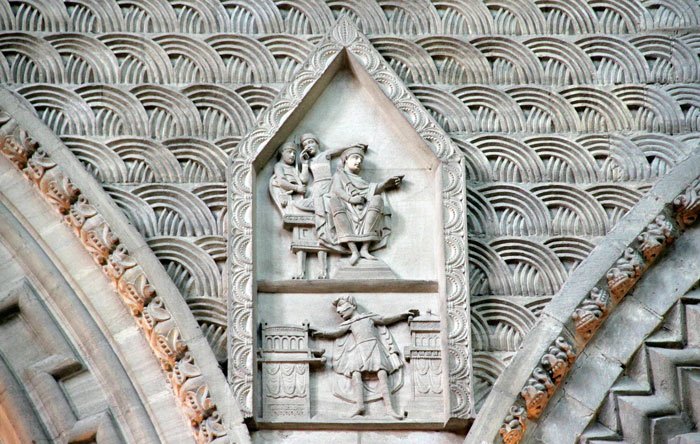Notre Dame de Bayeux is an interesting Gothic cathedral with an 11th-century Norman-Romanesque core dating from the times of William the Conqueror.
The Romanesque-Gothic cathedral of Bayeux is not the oldest, largest, or most impressive cathedral in France but it has a beautiful interior and a history that makes it well worth seeing. Most of the visible parts of the Bayeux Cathedral are Gothic but the church has a Romanesque core with even a few Carolingian elements in the crypt. Although Bayeux escaped the Second World War without any noteworthy damage, the exterior of the cathedral has not weathered the elements of the past few centuries too well. The interior with important Norman decorations is beautifully restored. In summer, the church is often open at night and beautifully lit.
The Bayeux Cathedral
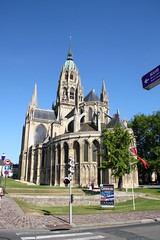 The present Cathédrale Notre-Dame de Bayeux is mostly Gothic in appearance although it has a Romanesque core. It was built to replace a large Carolingian church that burned down in 1047.
The present Cathédrale Notre-Dame de Bayeux is mostly Gothic in appearance although it has a Romanesque core. It was built to replace a large Carolingian church that burned down in 1047.
 Bayeux was of political significance during the 11th century. Here, William, duke of Normandy, often held court and had Harold, earl of Wessex, sworn an oath. The large Norman-Romanesque basilica built to replace the Carolingian church was thus far bigger and architecturally more advanced than would have been expected of a town the size of present-day Bayeux.
Bayeux was of political significance during the 11th century. Here, William, duke of Normandy, often held court and had Harold, earl of Wessex, sworn an oath. The large Norman-Romanesque basilica built to replace the Carolingian church was thus far bigger and architecturally more advanced than would have been expected of a town the size of present-day Bayeux.
 The new cathedral was only consecrated in 1077 by Bishop Odo in the presence of his half-brother William the Conqueror, king of England and duke of Normandy. Bishop Odo, also earl of Kent, probably commissioned the Bayeux Tapestry for display in the cathedral. The Bayeux Tapestry was displayed (or at least kept) at the cathedral until 1793.
The new cathedral was only consecrated in 1077 by Bishop Odo in the presence of his half-brother William the Conqueror, king of England and duke of Normandy. Bishop Odo, also earl of Kent, probably commissioned the Bayeux Tapestry for display in the cathedral. The Bayeux Tapestry was displayed (or at least kept) at the cathedral until 1793.
A fire in 1160 damaged the Romanesque church, which was repaired, rather than rebuilt, in a Gothic style. The vaulting and external decorations are Gothic but the frame is the original Romanesque, as can clearly be seen inside the church.
The Architecture of the Bayeux Cathedral
 The Cathedral of Our Lady in Bayeux is a triple-nave basilica. It has two 70-m high western towers over the ornamental western façade with five portals. This High Gothic façade and tympanums are unfortunately not in a very good condition. Neither are the tympanums on the portals of the transept, which includes on the south the martyrdom of St Thomas Becket.
The Cathedral of Our Lady in Bayeux is a triple-nave basilica. It has two 70-m high western towers over the ornamental western façade with five portals. This High Gothic façade and tympanums are unfortunately not in a very good condition. Neither are the tympanums on the portals of the transept, which includes on the south the martyrdom of St Thomas Becket.
The 95-m high central tower is built on a 15th-century square base. The current octagonal cap is Neo Gothic from the 19th century. It is no beauty but stylistically less offensive than some of the other unsuitable towers that collapsed or were replaced throughout the cathedral’s history, including a classical cupola in the 17thcentury.
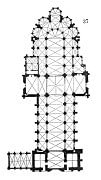 The chevet or apse is pure High Gothic and was built between 1220 and 1240.
The chevet or apse is pure High Gothic and was built between 1220 and 1240.
The nave of the Bayeux Cathedral is 96 m long, 23 m high, and 10 m wide, with the side naves 6 m wide and the side chapels adding a further 5 m. The transept is 10 m wide and 37 m long. The lower arches are Romanesque while the upper arches are Gothic.
 The interior of the cathedral is well restored and a successful harmonic blend of Romanesque and Gothic elements. Some statues and reliefs are fairly grotesque with the 13th-century iconography not always clear. Reliefs include amongst others a griffon, bishop, lion and Harold swearing an oath (as also seen in the Bayeux Tapestry).
The interior of the cathedral is well restored and a successful harmonic blend of Romanesque and Gothic elements. Some statues and reliefs are fairly grotesque with the 13th-century iconography not always clear. Reliefs include amongst others a griffon, bishop, lion and Harold swearing an oath (as also seen in the Bayeux Tapestry).
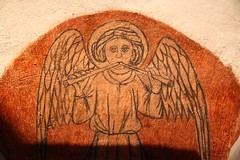 Many of the windows are in clear glass making the interior brighter than in many Romanesque-Gothic churches. Some of the stained glass windows in the northern end of the transept are from the 14th century but many are more recent. The carved choir stalls date from the 16th century.
Many of the windows are in clear glass making the interior brighter than in many Romanesque-Gothic churches. Some of the stained glass windows in the northern end of the transept are from the 14th century but many are more recent. The carved choir stalls date from the 16th century.
The crypt has strong pillars with Corinthian capitals and Romanesque vaulting from the 11th century. The paintings of angels – some playing musical instruments – and the frescoes are from the 15th century.
Visiting the Bayeux Cathedral
 Although a national monument, the Bayeux Cathedral is still a working church and thus open for free but with visiting restricted during services.
Although a national monument, the Bayeux Cathedral is still a working church and thus open for free but with visiting restricted during services.
The Bayeux Cathedral generally opens at 8:30 am and closes at 6 pm (7 pm from July to September).
In summer, the church is often open at night and it is well worth visiting then as the interior is beautifully lit to show the Gothic architecture and reliefs in the best possible light. From around 10 pm to midnight, the cathedral is basked in colorful lights.
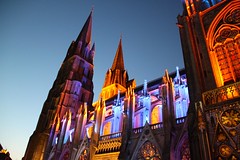 This colorful light show and special evening opening of the cathedral is usually from mid-July to end August on Tuesday, Thursday, and Saturday. A free light projection story of Normandy show is held on the same nights in the adjacent Hôtel du Doyen.
This colorful light show and special evening opening of the cathedral is usually from mid-July to end August on Tuesday, Thursday, and Saturday. A free light projection story of Normandy show is held on the same nights in the adjacent Hôtel du Doyen.
 The Bayeux Cathedral is in the heart of the old town – parking is not available in the direct vicinity but plentiful in the outskirts of the old town. It is a five-minute walk from the cathedral to the Bayeux Tapestry Museum and around 10 to 15 minutes to the Battle of Normandy Memorial Museum and the Bayeux War Cemetery.
The Bayeux Cathedral is in the heart of the old town – parking is not available in the direct vicinity but plentiful in the outskirts of the old town. It is a five-minute walk from the cathedral to the Bayeux Tapestry Museum and around 10 to 15 minutes to the Battle of Normandy Memorial Museum and the Bayeux War Cemetery.
- More photos of Bayeux Cathedral at Flickr.
